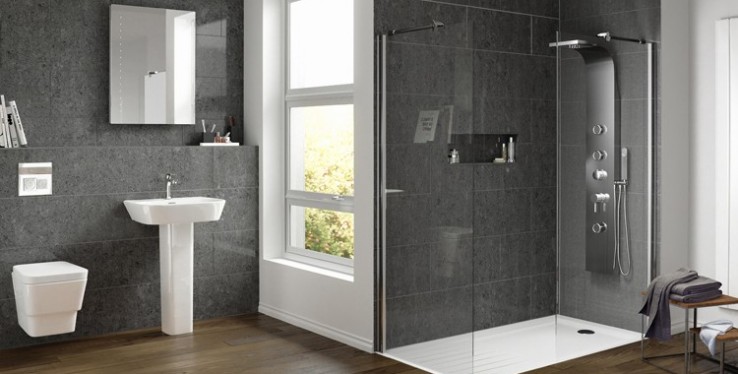5 tools to touch-up around bathroom tiles

Bathroom tiles are a hard-wearing and generally easy to clean surface, but unless your bathroom is a wetroom, it's likely that you still have some surrounding paintwork to touch up from time to time.
If you've just installed new luxury bathroom tiles, you'll want the rest of your decorating to do them justice - so here are five tools to add to your collection for a neat finish.
1. Paint stirrer
While you can use any old (clean) stick to stir paint, it is much much easier with a proper paint stirrer, and they won't break the bank.
A stirrer is typically a plastic stick with several holes in the surface, which help to mix the paint more thoroughly - easy to rinse after use, ready to be used again and again.
2. The right roller
Not all paint rollers are the same, so look for the right type - if your bathroom walls are rough you'll want the shaggier kind of roller for a more textured finish.
On smooth plaster, a less shaggy paint roller should still give good coverage, but with a smoother paint finish, making a good minimalist option only if your walls are pristine enough to pull it off.
3. Masking tape
Not strictly a 'tool', but still a toolbox essential, masking tape protects your tiles against any stray splashes of paint at the edges.
For even truer protection, consider taping newspaper sheets over the bathroom tiles to cover more of the surface - just remove them before there's any risk of the print transferring.
4. Mini roller
For the right textured finish close to the edges, a mini roller can get to the parts a full-sized roller wouldn't reach.
Again, look for the right type of mini roller - for smooth or rough wall surfaces - and you can be assured of an even closer match for the texture of the rest of your wall.
5. Edging brush
An edging brush, angled brush or 'nook and cranny' brush has a narrow head of bristles tilted forwards from the handle, making it easy to get into the edges where a normal paintbrush might lack precision.
Remove masking tape when the paint is not quite touch dry, but definitely dry enough not to drip - this should help to prevent the risk of bone-dry paint flaking or peeling off with the tape, and give a neat finish right up to the edge of your bathroom tiles.
Most Recent
Having embarked on a major extension for their beautifully renovated and greatly extended home, the Jafar family were keen to ensure that their all four of their bathrooms exuded elegance, as well as...
Having embarked on a major extension for their beautifully renovated and greatly extended home, the Jafar family were keen to ensure that their all four of their bathrooms exuded elegance, as well as...
Real Tiles & Bathrooms is proud to have supplied premium bathroom suites, high-quality tiles and kitchen flooring for a stunning new housing development in Woodford, Cheshire, delivered by long-te...
Archive
- June 2025
- May 2025
- March 2025
- February 2025
- January 2025
- December 2024
- November 2024
- September 2024
- August 2024
- July 2024
- June 2024
- April 2024
- March 2024
- February 2024
- January 2024
- November 2023
- October 2023
- September 2023
- August 2023
- July 2023
- June 2023
- May 2023
- April 2023
- March 2023
- February 2023
- January 2023
- December 2022
- November 2022
- October 2022
- September 2022
- August 2022
- July 2022
- June 2022
- May 2022
- April 2022
- March 2022
- February 2022
- January 2022
- December 2021
- November 2021
- October 2021
- September 2021
- August 2021
- July 2021
- June 2021
- May 2021
- April 2021
- March 2021
- February 2021
- January 2021
- December 2020
- November 2020
- October 2020
- September 2020
- August 2020
- July 2020
- June 2020
- May 2020
- April 2020
- March 2020
- February 2020
- January 2020
- December 2019
- November 2019
- October 2019
- September 2019
- August 2019
- June 2019
- May 2019
- April 2019
- March 2019
- January 2019
- December 2018
- November 2018
- October 2018
- August 2018
- July 2018
- June 2018
- May 2018
- April 2018
- March 2018
- February 2018
- January 2018
- December 2017
- November 2017
- October 2017
- September 2017
- August 2017
- July 2017
- June 2017
- May 2017
- April 2017
- March 2017
- February 2017
- January 2017
- December 2016
- November 2016
- October 2016
- September 2016
- August 2016
- July 2016
- June 2016
- May 2016
- April 2016
- March 2016
- February 2016
- January 2016
- December 2015
- November 2015
- October 2015
- September 2015

